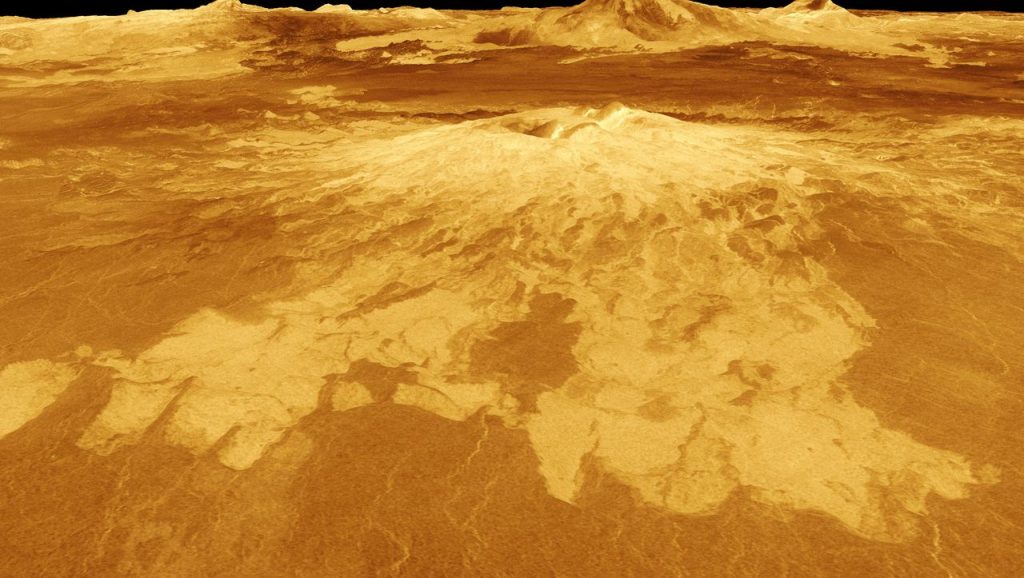There may be life on Venus, or rather above Venus: with this exciting message, researchers in September 2020 reported their measurements on our neighboring planet. At the time, astronomers recorded the effects of monophosphane. On Earth, this substance can be an indicator of microorganisms, because it is here that gas is formed as a metabolic product of microflora. It’s no wonder that miniature extraterrestrial life was quickly discussed at the time.
Admittedly, this probably wouldn’t be able to exist on the surface of Venus, as it would be very hot at 500°C. But there are also regions with milder temperatures in the atmosphere of Venus. Perhaps alien creatures are buzzing 50-70 kilometers above the Earth’s surface?
Probably not, a new study now confirms the objections raised after the Foshan study was published. Because even in the atmosphere of a life-friendly high planet, conditions are not sufficient for life to develop, an international research team wrote in Nature’s Astronomy magazine. John Hallsworth of Queen’s University Belfast and colleagues explain that there simply isn’t enough water there for life’s processes.
In the study, biologists describe the proportion of unrestricted water, that is, water available for life processes, with a value between 0 and 1. Life is only possible if water activity is greater than 0.585. This value also plays a role as an important limit value for the shelf life of food. Because if the water activity is less than 0.585, then there can be no harmful microbes there.
On the basis of a chemical analysis of conditions in the temperate zone of Venus’ atmosphere, Halsworth and his team show that the water activity in this region should have a value less than 0.004. According to scientists, the bioavailability of water is reduced to such a low level, especially by sulfuric acid droplets that are there. This means that there are no microbes there.
The situation is different with Mars: for its thin atmosphere, Halsworth and colleagues obtained a maximum water activity of 0.537, which is just below the limit favorable for life. Since climatic conditions on the Red Planet may have changed dramatically during its history, the atmosphere in earlier eras may have been more favorable for life.
Stormy pit under a magnifying glass
This is also supported by the result of a Another study by Elizabeth Lusa Adams from the University of Vigo in Spain and colleagues. The team analyzed X-ray measurements of sediment deposits in Gale Crater, made by the US spacecraft Curiosity. The craft has been in Gale Crater since 2012, where there was a lake in the early days of Mars. “Until now, we did not know whether the sediments were formed by the slow process of deposition or by short-term selective floods,” Losa-Adams and colleagues explain.
With the help of X-ray measurements, the researchers were able to examine the sediment’s crystalline structure and draw conclusions about the sedimentation path. Their finding: The sediment must have been deposited in calm waters over a long period of time. So the lake in Gale Crater was not only sparse water, but it provided living conditions for a much longer period of time – perhaps up to ten million years. The temperatures should also be pleasant at this time, because the water did not freeze into ice and did not evaporate very quickly. According to the researchers, life could have originated in the water-rich environment of the young planet Mars.
Soon after the 2020 Venus study was published, there was criticism of the work. Colleagues noted that they were unable to understand the data from the work. These were spectroscopic analyzes of the ALMA telescope in Chile and the James Clerk Maxwell Telescope (JCMT) in Hawaii. Radiation is searched for typical chemical signals already known. The frequency of light waves says something about the chemical composition of objects in space, for example. But in the case of Venus, instead of a monophosphine, astronomers found evidence of sulfur dioxide.

“Reader. Organizer. Infuriatingly humble twitter expert. Certified communicator.”




More Stories
Nvidia GeForce RTX 4090: AIDA64 gets Ada spearhead support
Rogue Trader – Details about the first cRPG in the series – CD-Action
t3n – Digital Pioneers | digital business magazine